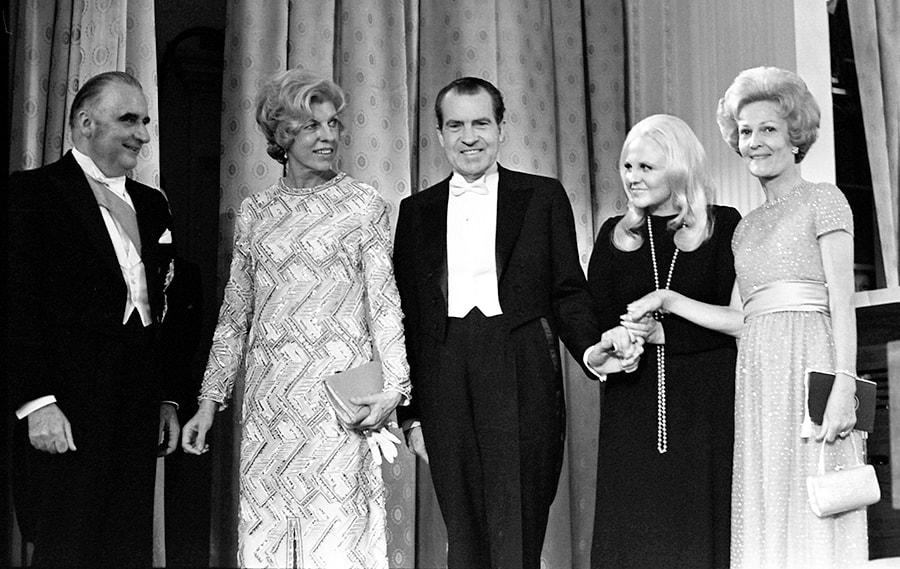Adapted from my book The Best Gig in Town:
|
Is “You know, more serious poetry isn’t that well accepted,” Peggy said. “In fact, to quote one writer, ‘To publish a book of verse is like dropping a rose petal down the Grand Canyon and waiting for the echo. . . . And I know. I wrote a book of verse and I dropped it into the Grand Canyon.’”
Peggy went on, “But then I couldn’t say that all poetry is not accepted because lyrics are poetry and they are accepted. Although, so many today are sentimental, sad, down. And I, for the most part, prefer the song of the optimist, because without the optimist, the pessimist would never know how happy he wasn’t, right? And then I couldn’t say that all lyrics are poetry because so many things they are writing today are little stories, little vignettes.” Peggy’s rap on poetry was neither coquettish nor dilettantish; she genuinely loved the spoken word, as one would expect of a lyricist of her caliber. She read poetry regularly on her radio show way back in 1952, reciting William Butler Yeats before singing “These Foolish Things,” for example. Her emphasis on poetry—and especially contrasting the pessimist with the optimist—was no doubt her way of introducing her current surprise hit song written by chart-masters Jerry Leiber and Mike Stoller. A most unusual pop number, “Is That All There Is?” intersperses morbid spoken verse with a catchy hook, a song that could easily be a turnoff for most on first hearing—as it was in fact for Peggy—but one that gathers meaning upon repeated hearing. After all, a song where the narrator’s memory is of her house burning down as a child (it happened to Peggy twice), a trip to a so-so circus, and lost love (Peggy knew only too well) but “let’s keep on dancing . . . and have a ball” is the stuff of an Oprah Winfrey book. So it has a "keep smiling in the face of adversity" side, but on first hearing, it may not be too clear. One would have thought that most in the East Room audience had already heard it. It was the buzz song of the year, helped along by its mysterious quality and the controversy it generated. The single version of “Is That All There Is?” had been out for a whole year—throughout 1969, Peggy had sung the song at her nightclub engagements and on national TV. An album of the same name had filled record store bins for the previous three months, and the trade press buzzed with speculation that Peggy would win a Grammy for the song (which she did two weeks after the Nixon event). Yet to the East Room glitterati, the song was a bummer; it received only polite applause. Maybe the spoken opening phrase turned them off. Peggy had uttered in a near whisper, “I remember when I was a little girl, our house caught on fire—and it did, Mr. Nixon.” After the lukewarm response to the song, Peggy asked, “Well, I don’t want to sing good night right now, if you don’t mind. Do you?” Only a few in the audience answered no.[1] |
Leiber, for one, found himself reading the likes of Thomas Mann—in particular, the short story Disillusionment. This literary work inspired him to write loosely connected verses of a disillusioned woman, to be spoken, not sung.
The first verse is about a little girl watching her house go up in flames who asks, “Is that all there is to a fire?” The second verse centered on a day at the circus has the narrator asking, “Is that all there is to a circus?” The third verse about a love affair gone wrong and the fourth about a final disappointment elicit similar questions.
Leiber presented his four bittersweet, cabaret vignettes to Stoller, who immediately wrote music to capture the spirit of Kurt Weil and Bertold Brecht. The pair showed their work to English singer-actress Georgia Brown, who, in need of a song for a London TV special, suggested it needed a chorus, something for her to sing between verses. The two collaborated as usual and came up with the perfect song-saving chorus that included the lines: “Then let’s keep on dancing” and “Let’s break out the booze and have a ball.”
Georgia performed the song on TV, but the BBC didn’t record it. The boys wanted a single and began a search for someone who would be acceptable to a record company. They approached actress Marlene Dietrich, who, in their estimation, would be perfect for a cabaret song. She turned them down: “That song you just sang to me is what I am, not what I do.” They then sent the song to Barbra Streisand. No reply ever came.
Then they thought of Peggy Lee. She had recorded their “I’m a Woman,” which was an across-the-board hit. Jerry handed her a demo of the song at a party. A week later, she called: “I will kill you if you give this song to anyone but me. This is my song. This is the story of my life.”
In January 1969 the songwriters joined Peggy in the studio. “I’ll do three takes” she said, “and no more.” It was a struggle. She did 36 takes; the last one was heavenly perfect. But the engineer had forgotten to push the “record” button. One more take—number 37—is the one the world would come to know.
But then Capitol Records refused to release it. At that point in her career, Peggy wasn’t selling records, and this new one—this existential treatise, Stoller called it—was hardly what the company wanted to hear.
But for Peggy, that wasn't the end of the story.
Capitol Records wanted to promote some of their new acts and hoped to get them on Joey Bishop’s late-night TV show. Joey wasn’t that interested in those artists, but agreed to host them if he could also get Peggy.
Always cagey, Peggy saw her chance. “I’ll go on the Bishop show,” she said, “if you release ‘All There Is?’ because that’s the song I’m singing on the show!” Capitol capitulated.[2]
The question remains. If the East Room crowd at the Pompidou State dinner had known all this, would it have made a difference? Probably not.
And if that British singer hadn’t suggested the pair’s existential treatise needed an upbeat chorus, would it ever have been a song?
And if comic Joey Bishop hadn’t had a thing for Peggy, would Capitol Records have ever allowed her to record it?
And if Peggy had thrown her hands in the air and walked out after learning the recording engineer had forgotten to push the record button after the perfect take, achieved after a grueling 36 takes in a row, would it ever have been a song?
Probably not, all around. Still, it became a song, a most unusual hit song at that.
Serendipity Doo-Dah!
- Edward Allan Faine, The Best Gig In Town: Jazz Artists at the White House, 1969–1974 (Takoma Park, MD: IM Press, 2015), 51–52.
- Jerry Leiber and Mike Stoller with David Ritz, Hound Dog: The Leiber & Stoller Autobiography (New York: Simon & Schuster, 2009), 234–46.




 RSS Feed
RSS Feed